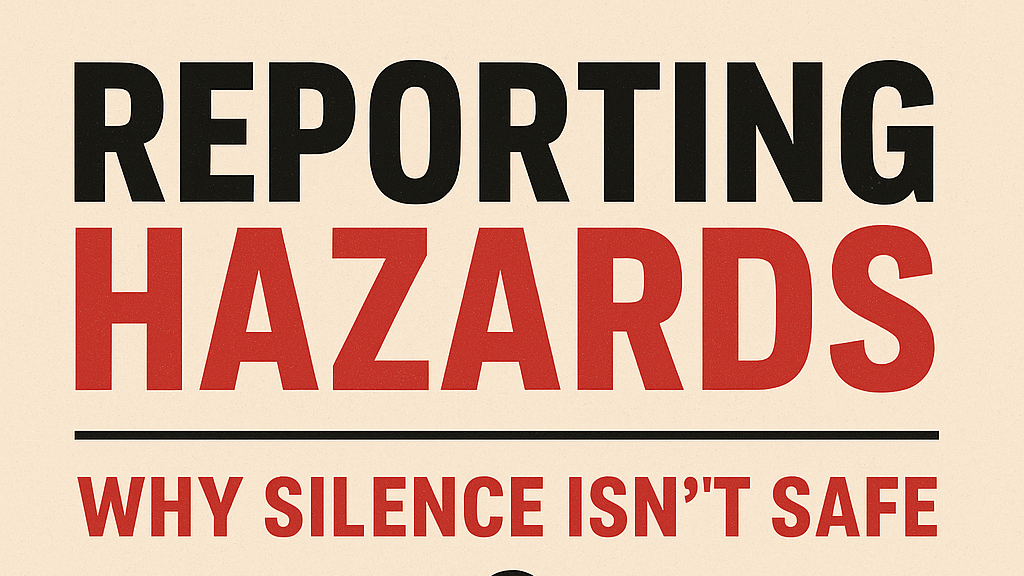Reporting hazards is a vital practice in every workplace—one that directly impacts injury rates, morale, and organizational integrity.
At the beginning of every shift, before the first task is started, workers encounter potential risks.

These might seem small or “not worth reporting,” but when left unaddressed, these minor issues can become major accidents. Staying silent is not safe—it’s dangerous.
The Real Consequences of Not Reporting Hazards
Failing to report a hazard doesn’t make it go away—it often makes it worse. Consider a small oil leak on a warehouse floor. If not reported, it may cause someone to slip. That single injury could lead to downtime, workers’ compensation claims, and low team morale.
Ignoring hazards also sends a message to others: “Safety isn’t a priority here.” Over time, this mindset can erode the entire safety culture of a company, leading to more incidents, greater liability, and even reputational damage.
Common Reasons Workers Don’t Report Hazards
Understanding why workers remain silent is the first step to solving the problem. Here are the most common reasons:
- Fear of retaliation or blame
- Uncertainty over what constitutes a reportable hazard
- A belief that someone else will report it
- Lack of training on how to report
- Poor past responses from management
Companies must work actively to eliminate these barriers and build trust in the hazard reporting process.
What Is a Hazard?
A hazard is any source of potential damage, harm, or adverse health effect on something or someone under certain conditions. Examples include:
- Spills or leaks
- Blocked emergency exits
- Faulty tools or equipment
- Exposed wires or damaged insulation
- Broken ladders or platforms
- Poor lighting in walkways
- Confined space hazards
- Chemical exposure
- Unstable loads or stacking
When in doubt—report it.
Creating a Reporting Culture
To foster a proactive safety culture, hazard reporting must be:
- Easy – Reporting should take minutes, not hours.
- Anonymous options – Some people prefer discretion.
- Rewarded, not punished – Thank employees who report.
- Acted upon – Show that reports lead to real change.
- Trained regularly – Reinforce it through toolbox talks and drills.
Internal Link: At your workplace, see our guide on Essential Safety Training for All Employees to support a safer culture.
What Should a Hazard Report Include?
A complete hazard report should contain:
- Date and time
- Location of the hazard
- Description of the issue
- Who or what is at risk
- Photos if possible
- Suggested immediate actions
Digital hazard reporting tools, like mobile apps or internal portals, make it easier than ever to submit clear and quick reports.
Who Is Responsible?
You. Everyone.
While safety officers, supervisors, and HR teams oversee hazard mitigation, it’s the responsibility of every employee to report what they see.

Security guards, janitorial staff, drivers, technicians, and even office staff must know they play a role in protecting their colleagues.
Real-Life Example: One Report, Big Impact
At a distribution center in Ontario, a security guard noticed a damaged emergency exit door handle during routine patrol. He filed a quick report through the mobile app.
Within 24 hours, it was replaced—and a week later during a fire drill, that very door was used to evacuate a group of employees. Had he stayed silent, the outcome might have been drastically different.
Link to Training and Follow-up
Regular safety toolbox talks on reporting hazards should be mandatory. Review case studies, give examples of past incidents, and remind workers of reporting channels.
Here are helpful external resources:
- CCOHS: Reporting Hazards (DoFollow)
- OSHA: Identifying Hazards (DoFollow)
- OHSE.ca: Canadian Safety Insights (DoFollow)
Speak Up, Save Lives
Reporting hazards is one of the simplest, most powerful actions an employee can take. It requires no special gear, no advanced knowledge—just awareness and a commitment to safety.
Silence isn’t strength. It’s a risk. Speak up, take action, and encourage others to do the same.

No comments yet